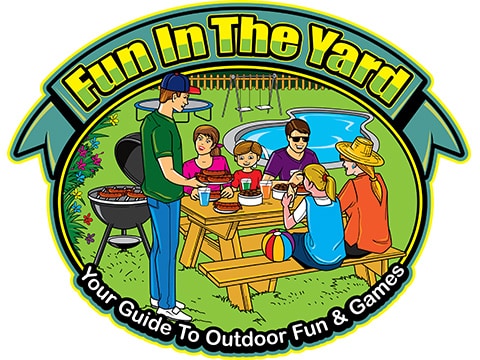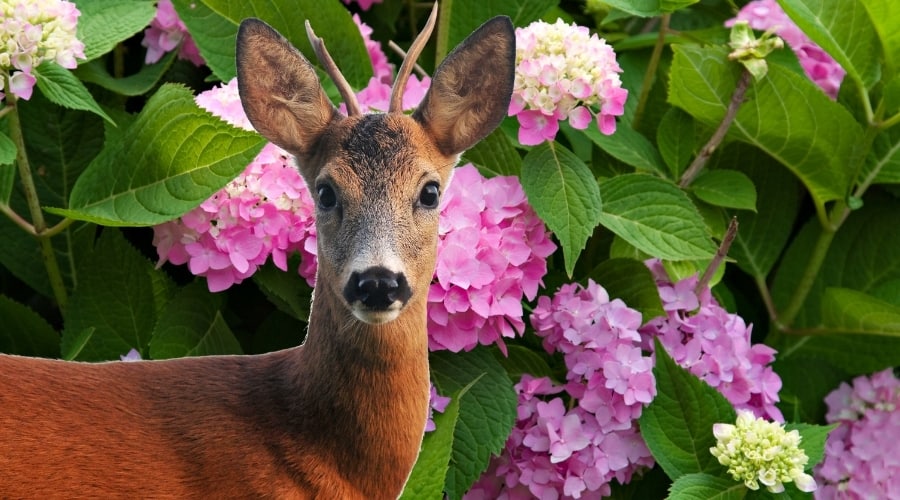Hydrangeas are beloved by many gardeners because they take little effort to produce its flowers. Safeguarding the plant against deer on the other hand, is the tougher job. Do deer eat hydrangeas? What can you do to protect your flowers from deer?
Deer are known to eat hydrangeas in the wild and from rural backyards. Wildlife experts say they are lured by the colors of the hydrangeas however they don’t love its taste. They’re most likely to eat hydrangeas in winter when food sources are scarce.
The notion that deer love hydrangeas is a misconception. More often, they take a mouthful, realize there is tastier food elsewhere and leave. Unfortunately, their short-term memory means they’re liable to return for another try.
Table of Contents
Do Deer Like To Eat Hydrangeas
Wild deer will and can eat hydrangeas. They don’t like them as much as their curiosity drives them to investigate the brightly colored flowers.
Like most herbivores, deer are constantly foraging and using their mouths to answer questions about their environment, one of the most important being ‘Can I eat this?’
Regardless, they can do a lot of damage to hydrangea bushes in backyards, stripping flowers from the branches and destroying the tender green buds.
If you live in a semi-rural neighborhood with urban development that’s encroaching on wild areas, you’re much more likely to see wild deer treating your hydrangea plants as a food source.
Despite being mildly toxic, the plants are tolerable to deer and represent an easy feast when options are limited and/or a population has outgrown its preferred food sources.
This is most likely to occur in the winter months and it’s thought the deer specifically look for the hydrangeas’ exposed stalks. Some gardeners successfully deter foragers by concealing the stalks with leaves or light mulch until the spring.
Do Deer Eat Limelight Hydrangeas
- Cream, white or pink flowers
- Grows huge 10-inch blooms in flower
- Flowers from summer to fall
- Resistant to cold and frost
While there’s no evidence to suggest deer are especially fond of limelight hydrangeas, these plants are highly frost resistant.
The fact they’re more likely than some other varieties to be around in winter means they’re vulnerable to deer.
Do Deer Eat Oakleaf Hydrangeas
- White and purplish-pink
- Grows 6 to 12-inch blooms
- Flowers in summer (May to July)
- Spreads through suckering
Oakleaf hydrangeas are commonly referred to as ‘deer resistant’ but it isn’t always the case. There’s some evidence to suggest oakleaf plants are less likely to be nibbled by deer but plenty of gardeners have stories to refute the claim.
Some wild deer can and will pick at this variety as readily as other types of hydrangeas.
Do Deer Eat Pee Gee Hydrangea
- White and pink
- Grows 6 to 8-inch blooms
- Flowers throughout summer
- Highly tolerant to pollution and urban conditions
Pee gee hydrangeas are among the varieties least likely to be eaten by deer though all hydrangeas can be foraged.
This may be due to its tolerance for urban environments and willingness to grow in tough areas such as along highway verges.
Do Deer Eat Annabelle Hydrangeas
- White and green
- Grows blooms as tall as 10-inches
- Flowers in late summer (July to August)
- The flowers can get heavy enough to bend the stalks
Sadly, for gardeners who adore these showy white plants, they’re the most commonly foraged by deer.
Out of all the hydrangea varieties, deer seem to prefer Anabelles, sometimes going out of their way to pick off the plant’s tender green buds.
Do Deer Eat Endless Summer Hydrangeas
- Pink, purple, blue, red and white
- Grows blooms 8 to 10-inches tall
- Flowers in spring and summer
- One of the earliest varieties to bloom
Endless summer hydrangeas can be especially vulnerable to deer because they bloom so early in the year.
If the winter has been particularly harsh on local deer populations, their blue and purple flowers are an irresistible lure.
Do Deer Eat Bobo Hydrangeas
- Reddish-purple
- Grows blooms 6 to 9-inches
- Flowers throughout summer
- One of few varieties which cannot be changed by soil P.H
While there isn’t much information about deer’s preference for bobo hydrangeas, it can be assumed they will eat these plants when other food sources are scarce.
Bobo hydrangeas are a more compact variety than some others so they may have some natural protection simply because they’re lower to the ground and less visible.
Do Deer Eat White Hydrangeas
Lots of hydrangeas produce striking white flowers so they’re arguably the most vulnerable varieties because their blooms are the most common.
They’re very easy for roaming deer to spot as they stand out against the green foliage in a striking way. It’s likely this is the reason white hydrangeas get nibbled so often rather than the plants containing anything specific that attracts the deer.
Deer avoid plants with strong scents such as wild herbs and plants with thick, leathery leaves like yucca.
If they can avoid them, they give prickly plants like thistle a miss but have been known to eat roses and other thorny flowers in a pinch. Even plants with robust defense mechanisms (thorns, mild toxicity, etc) are no match for a ravenous buck.
It’s worth noting that the foraging preferences of wild deer differ from region to region. Where some populations will leave a certain variety of hydrangea (oakleaf hydrangea) untouched year-round, the deer in a different location will happily pick at them.
This makes it difficult to devise anti-foraging strategies that work for gardeners across the country. A strategy that’s effective in one area may be futile in another because the deer are interested in completely different plants.
Will Hydrangeas Grow Back If Eaten By Deer
The good news is that hydrangeas are surprisingly resilient and almost always survive an intensive nibbling. It helps that deer are rarely there to feast on the plant’s flowers.
As discussed, they’re curious animals that are used to exploring the world via their mouths. They don’t love the taste of hydrangea flowers and usually only eat them if they can’t forage alternative food sources.
More often, they eat the hydrangeas’ young buds and upper parts of their flowers. This still causes damage but it’s much easier for the plant to recover from.
Provided some young buds are left undamaged, a hydrangea should have no problem flowering again when the time comes.
Younger hydrangea plants are more vulnerable than older ones. So, if you’re working on anti-foraging strategies to protect your plants, focus on the younger ones.
If roaming deer decide to visit your garden, they’ll be most interested in these flowers.
How Do You Keep Deer From Eating Hydrangeas
There are no truly deer-resistant hydrangeas, only some hydrangea varieties that some people claim some deer don’t like.
Including certain types of flowers in your garden and excluding others is a strategy that you can try but, if it doesn’t work, here are some alternative methods to deter those pesky foragers:
1 – Hang Soap Around the Yard
Deer are exceptionally sensitive to smells relying on their olfactory systems to find food and avoid predators. They’re very wary around strong odors they don’t recognize and most treat unfamiliar smells as an unnecessary risk.
Some homeowners have had success with placing bars of strong-smelling soap around their gardens.
Wildlife experts say soap’s tallow is particularly repellent to roaming deer and that hanging bars within three feet of vulnerable hydrangeas will discourage them from foraging.
Remember, the stronger your soap smells the better it will function as a deer deterrent. But avoid soaps containing coconut because this scent can attract animals.
2 – Mix Up A Stinky Homemade Repellent
If hanging bars of soap doesn’t work, it’s time to take Operation Smell to phase two. Have a rummage in your kitchen cupboards for some staple ingredients; let’s create a homemade deer repellent spray.
- 1 gallon of warm water
- 3 eggs
- 3 tablespoons of milk or yogurt
- 3 crushed/minced garlic cloves
- 3 tablespoons of cayenne pepper
Combine all the ingredients (but just 3 cups of the water, to begin with) in a blender and blend into a smooth, smelly puree.
Strain the mixture to remove any lumps, add the remaining warm water and set aside for twenty-four hours. When you return, the mixture is going to be pretty stinky so this method might not be suitable for those with sensitive stomachs.
Transfer the deer repellent to a spray bottle and liberally spritz your hydrangeas when their leaves are dry (wait if it’s just rained or there’s dew on the plants).
Cover as much of the vulnerable plant as possible. The odor will be strong at first, but you won’t be able to smell it when the repellent is dry.
Deer and other ruminants can sniff out overripe casein from a mile away and will, hopefully, give your yard a miss.
3 – Grow Some Anti-Deer Plants
Hydrangeas might be tasty right across the board but there are other plants deer don’t like and normally avoid.
Anything with a strong scent tends to be repellent to the animals and, fortunately, this includes some magnificent species.
Boxwoods, lavenders, foxgloves, poppies and ferns have all been used as deterrents by gardeners trying to protect their hydrangeas.
If you’ve got prize hostas, tulips or hydrangeas in your backyard, all common targets for wild deer, try growing strong-smelling plants close by.
It’s a very green, wildlife-safe deterrent that ends up making your garden more beautiful while safeguarding it from unwelcome visitors.
4 – Put Your Favorite Radio Station On
This is an old-fashioned trick, but it’s still used by rural homeowners. Get yourself a solar-powered radio or two. Switch them on and position them in the middle of your garden, close to the hydrangeas or in the path of the deer if you know where they enter.
Keep the radios switched on at a low to medium volume indefinitely to scare off any animals bold enough to sneak in. The unusual sound should startle foraging deer and have them running for the exit before they reach your flowers.
Helpful Tips To Know About Deer Eating Hydrangeas
Here are some things to remember when planting hydrangeas in areas where wild deer are common:
- There is no such thing as a deer-resistant hydrangea. These animals have been observed eating every variety of hydrangea and their preferences differ according to the habits and needs of their population.
- Wild deer eating hydrangeas is a bit of a misconception. They will eat these plants if other food sources are unavailable but, most of the time, they nibble and pluck at the plants out of curiosity. Unless a deer is very hungry, they won’t feast on a whole hydrangea plant.
- Early bloomers (spring hydrangeas), white hydrangeas and hydrangeas that grow on old wood are particularly attractive to deer just because they’re easier to see and locate. Late-blooming varieties and varieties that grow short and squat such as the bobo hydrangea have a natural advantage as they’re harder to find.
- Deer have an intense dislike for strong smells so combining pungent ingredients is a safe and wildlife-friendly way to deter them from foraging. Foods like egg, milk and yogurt smell very strong as they ripen and pose too much of a risk for ruminants that need a clear nose to avoid predators.
Final Thoughts
The battle between gardener and wild deer has been waged for a long time and it can get frustrating to put hard work into tending plants that are under constant attack.
The important thing to remember is these animals aren’t out to ruin your garden or your prized hydrangeas. There’s usually a reason they’re not off eating their favorite foods instead like scarce resources, urban encroachment, sickness, or injury, and all you need to do is remind them your flowers aren’t an easy target.

